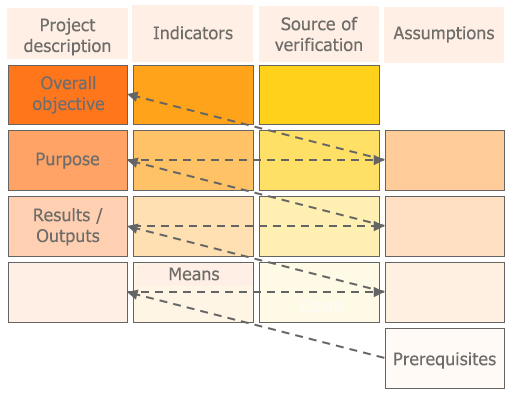The result of the Logical Framework Approach (LFA) is a Project Planning Matrix (PPM), which shows the interrelation of the four hierarchical levels – overall goal, objective, expected result, and activities – in a logical fashion. For each level, indicators and external factors have to be identified.
|
WHY |
a project is carried out (= overall goal) |
|
WHAT |
the project is expected to achieve (= objective) |
|
HOW |
the project is going to achieve ist results (= expected results) |
|
WHICH |
external factors are crucial for the success of the project (= risks and assumptions) |
|
HOW |
we can assess the success |
|
WHERE |
we will find the data required to assess the success (= means of verification) |
|
Overall Goal |
Impact Indicators |
External Factors/Assumptions |
|
Purpose The higher level objective towards which the project is expected to contribute |
Measures to verify to what extent the overall goal is fulfilled |
Important events, conditions or decisions necessary for sustaining the overall goal in the long run |
|
Results The effects that are expected to be achieved as a result of the project |
Measures to verify to what extent the immediate objective is fulfilled |
Important events, conditions or decisions outside the control of the project which must prevail for the overall goal to be attained |
|
Outputs The outputs that the project should deliver |
Measures to verify to what extent the outputs are produced |
Important events, conditions or decisions outside the control of the project necessary for the achievement of the objectives |
|
Activities Activities that have to be undertaken by the project in order to produce the outputs |
Goods and services necessary to undertake the activities |
Important events, conditions or decisions outside the control of the project necessary for the production of the outputs |

Source: Project Management Handbook, A Working Tool for Project Managers; www.novartisfoundation.org/platform/apps/Publication/getfmfile.asp?id=61...